
Copyright © Randy Strickland, 1998, 1999, 2000, 2001, 2002, 2003, 2004, 2005, 2006, 2007, 2008, 2009, 2010, 2011
|
|
||||||||||
|
||||||||||

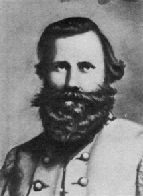
|
This part of my site is a dedicated to the life of Major General James Ewell Brown Stuart, considered as the South's last Cavalier. Given command as Chief of Cavalry of the Army of Northern Virginia, General Stuart was General Lee's "Eyes" and was ably suited as a dashing, poetic, example of the fighting spirit of the Confederacy.
|
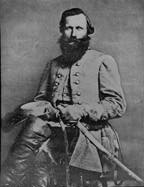
|
Major General Stuart was born in Patrick County, Virginia on February 6, 1833. His father, Archibald Stuart was a lawyer, soldier in the War of 1812, and a highly thought of representative in both Virginia legislature and conventions. James Stuart as a young man, pursued his studies at Emory and Henry College and was later appointed to the United States Military Academy at West Point. He graduated with the class of 1854 and as a newly commissioned Second Lieutenant was assigned to Texas. There he was engaged in many excursions against the Apache and in 1855 was reassigned to the First Cavalry in Fort Leavenworth, Kansas. In November of 1855, James Stuart married the daughter of a future nemisis, Colonel Philip St. George Cooke. In the years of the War Between the States, General Stuart would engage in battle and be pursued by troops under the command of his Father-in-Law. Another of the many sad truths of family against family in the American Civil War. Soon after his marriage, Stuart was promoted to the rank of First Lieutenant. His service carried to the far corners of the "Frontier" and he fought in many battles against the Indians. In 1857 he was wounded at the Battle of Solomon's River.
|
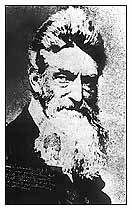
|
Still a First Lieutenant, Stuart gained notoriety in his part at Harpersferry, Va. in the retaking of the Federal armory and arsenal than occupied by John "Ossawatomie" Brown and his band of abolitionists. Serving under Colonel Robert E. Lee and tasked with reading the "Summons of Surrender" to John Brown and then was instrumental in leading a company of Marines in storming the building and forcibly removing the abolitionists from their strong hold. This was the first of many battles in which J.E.B. Stuart would serve under the future Commanding General of the Confederate Armies, Robert E. Lee.
|
|
Just before the start of the War of Northern Oppression, James Stuart was promoted to the rank of Captain, but resigned on May 7, 1861 to follow his state of Virginia into the Confederacy and to tender his services to her. He was immediately given a commission as Lieutenant Colonel in the Virginia Infantry. Later, he was promoted to Colonel and given comand of Cavalry with which he quickly gained the respect of both his men and commanders as he became the "Eyes of the Army" and screened the early movements of the Confederate army. During the Battle of First Manassas, Colonel Stuart led his cavalrymen in pursuit of the fleeing Union army and occupied the heights just outside of the Union capital, Washington. In September of 1861, only two months later, he was promoted to the rank of Brigadier General.
|
|
During Union General McClellan's Peninsula Campaign, General Stuart was called upon by the new Commander of the Army of Northern Virginia, General Robert E. Lee, to reconnoiter in force and find the Union army's exact position. In mid-June of 1862, General Stuart led 1,200 troopers on a ride that completely encircled McClellan's army. Not only had he accomplished his tasks as given, he embarrased the Union commander and evaded a hot pursuit led by his Father-in-Law, Union Cavalryman Philip St. George Cooke. In July of 1862, the indomitable Cavalryman was promoted to Major General. Once asked about his gaudy trappings, which by now had become famous, he said, "We must substitute espirit for numbers, therefore I strive to inculcate in my men the spirit of the chase." He was well known for his yellow sash, scarlet lined cape, plumed hat and jack boots.
|
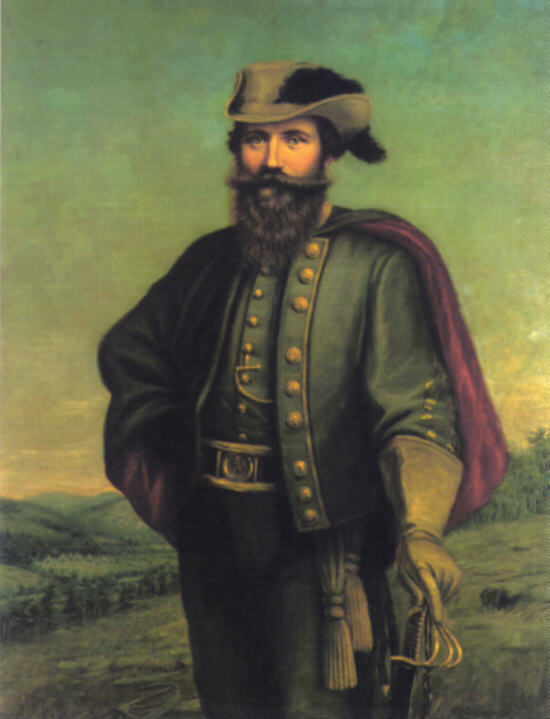
|
|
Union General Pope was held at bay by General Jackson's troops as he moved towards Gordonville, Virginia. After General Pope retreated to the other side of the Rappahannock River to await reinforcenments from McClellan, General Lee sent General Stuart to "tear things up in the Federal rear." General Stuart had lost his favorite plumed hat in a skirmish a few days earlier and had determined to make the "Yankees pay for that hat." General Stuart was able to raid General Pope's headquarters at Catlett's Station, seized $350,000 in cash, the Union Commander's dress uniform coat, and General Pope's dispatch book which listed the disposition of the Union forces. General Stuart provide this valuable information to General Lee which resulted in a brilliant campaign as General Jackson attacked the Union positions at Manassas Junction, starting the Second Battle of Manassas. After this battle, General Lee determined to take the fight to the Union north. He split his army and sent part to Harpersferry to deal with the 12,000 man Union garrison there, while the second half moved towards Hagerstown, Maryland...twenty miles further north. General Stuart and his troops were left in place on General McClellan's front to screen the movements of the Confederate army. As we know now, General Lee's famous lost Order No. 191, was found and given to General McClellan and he was able to move his Union troops to cut off the movement of the Confederat army. Thanks to the ever faithful General Stuart, General Lee knew of McClellan's discovery within twenty-four hours. General Lee began to regather his disconnected army and determined to fight at Sharpsburg, Maryland... also known as the Battle of Antietam. General Stuart, along with Generals D.H. Hill and Longstreet, was able to fend off the Union advances at South Mountain and gave General Lee the valuble time he needed to rejoin his thinly spread army. As the Battle of Antietam was joined, General Stuart's position was on the Confederate left. As Union General Sumner's II Corps was brought forward against the Confederate positions, General Stuart's famous horse artillery brought them under a terrible fire. The combined forces of Generals Lafayette McLaws, John Walker, and Jubal Early, closely supported by General Stuart, was able to repulse the Union attack. Union General Sumner upon observing the slaughter screamed, "My God, we must get out of here!" Nearly half of his 5,000 man force had been shot and the others fled.
|
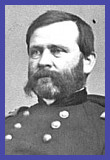
|
December of 1862 finds the valiant General Stuart at Fredericksburg, Va. where he faced the advancing Left Grand Division of the Army of the Potomac under the command of Union General William B. Franklin. Once again, the Horse Artillery under John Pelham of Alabama draws two field pieces into the open and held the Union movement at bay. As they found many times, General lee and his Lieutenants, Generals Jackson, Longstreet and Stuart proved too much for the Union troops and they retreated to the other side of the Rappahannock River.
|
|
The spring of 1863 would prove to be very eventful for both the Union and Confederate armies. As the unpaved roads dried and the temperatures warmed the troops, General Joe Hooker, new commander of the Army of the Potomac, led his men to once again move against that of General Lee. General Lee had split his forces and had sent General Longstreet and his Corp to the south east to counter Union movements in and around the lower James river. General Lee's army now only numbered approximately 60,000 men against the overwhelming odds of the Union army, numbering nearly twice that. Keeping the Confederate army in check at Fredericksburg, General Hooker moved 2/3 of his army to the north and would move against the Confederate left. This would have worked had it not been for General Stuart and his cavalry controlling the roads around Chancellorsville, screening the movements of the Confederates.
|
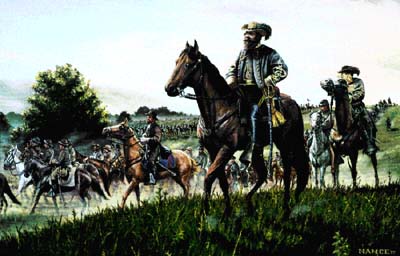
|
Unsure of what his adversaries were up to, General Hooker had his troops dig in to field positions. General Lee split his army again and sent 26,000 men under General Stonewall Jackson on a swing around the Union right. This move defeated the Army of the Potomac, but at a terrible price... General Jackson was mortally wounded by his own men on the evening of May 2, 1863. General Stuart was given command of Jackson's Corp and continued the fight in Hazel Grove and began shifting to the right to rejoin with General Lee and the rest of the Confederat army. The combined forces of Generals Lee and Stuart relentlessly attacked the Union forces near Chancellorsville clearing. The Confederate artillery fired a storm of shot into the Union troops, even at times firing pieces of railroad rail. General Hooker's army is shocked and beaten back aqcross the Rappahannock River. Even though General Stuart played a great part in this enormous victory, it was an empty victory, as less than a week later, on May 10, 1863, murmuring "Let us cross the river and rest under the shade of the trees", General Stonewall Jackson succumed to complications caused by his wounds and was lost forever. General Lee said, "I have lost my right arm" and none of the Army of Northern Virginia would ever be the same again.
|
|
Soon after their victory at Chancellorsville, General Robert E. Lee and President Jefferson
Davis decided the most logical course of action woulld be to once again take the war to the North. This would lessen the burden on Virginia and perhaps turn some of the attantion away from the beseiged city of Vicksburg, along the Mississippi River. The Army of Northern Virginia flanked the Army of the Potomac and moved into the Shenandoah Valley. By June 5, 1863, Generals Longstreet and Ewell, along with their two corps of infantry, were camped in and around Culpeper, Virginia. Just six miles north of town, Gen. J.E.B. Stuart bivouacked his division of cavalry, screening the Army of Northern Virginia against surprise by the pursuing enemy.
|
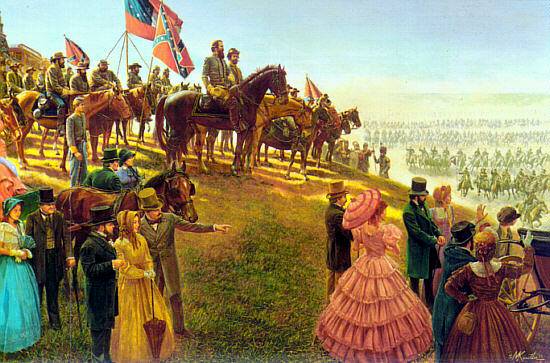
|
Most of the Southern cavalry was camped near Brandy Station. General Stuart, wanting to add to the espirit de corps his troops had become so famous for, requested a full field review of his troops by his commanding officer, Gen. Lee. His request was granted, and on June 8 nearly 9,000 mounted troopers passed General Lee's reviewing stand, in a full gallop, sabers glistening, while 22 batteries of horse artillery roared in mock battle.
|
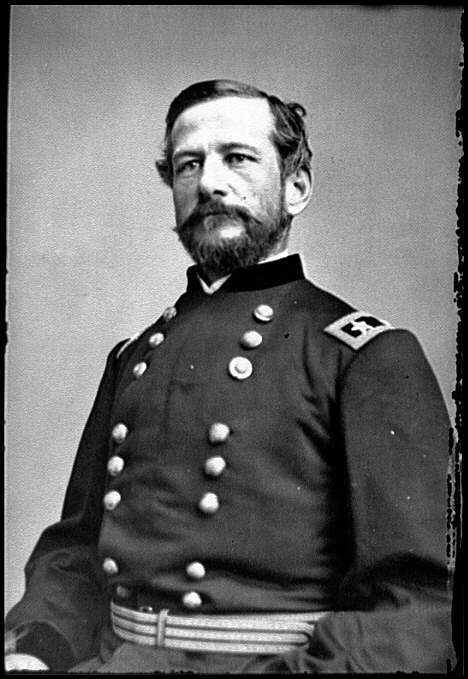
|
Unknown to General Stuart and his Confederate troopers, 10,000 Union horsemen had massed their forces on the other side of the Rappahanock River. Union General Pleasonton having misinterpreted the screening action of General Stuart's cavalry, believed he was about to attack a rebel raiding party. General Pleasanton's attack plan called for a two-pronged attack. One half of his men would cross the river at Beverly's Ford, two miles below Brandy Station, and the other half would cross at Kelly's Ford, four miles downstream. General Pleasonton believed that once caught in this pincer like movement, the Southern Cavalry would have no recourse but to capitulate and surrender to him.
|
|
Early that morning, intermittent gunfire could be heard from the direction of the river. General Stuart, at his headquarters at Fleetwood Heights, would be given the news that Union cavalrymen had forced a crossing at Beverly's Ford and were moving toward St. James Church and Gee House Hill. After hearing that his troopers had checked the enemy movement at St. James Church, he learned that Union troops were riding in on his rear. The vanguard, then visible, was approaching his headquarters from the Stevensburg Road, having crossed at Kelly's Ford and reached Stevensburg via La Grange. Leaving a lone artillery piece atop Fleetwood Hill, accompanied by a mere token force to guard his headquarters, General Stuart called for his troops at St. James Church to rush back to meet this new threat. However, they were too late, General Stuart's headquarters were overrun and the lines at St. James were threatened.
|
|
Arriving, literally in the nick of time, Gen. W.H.F. (Rooney) Lee's cavalry rode in from Little Fork Church (seven miles from Brandy) and saved the day for Stuart. After 12 hours of raging battle, Union troops retreated to the north side of the river. This was the largest and greatest cavalry battle on the North American continent. Over 19,000 mounted men were engaged in this battle. It was at this battle that the Union Cavalry showed its' new found metal, skills never before shown in any other battle up to this point in the war.
| 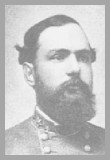
|
|
After the Battle of Brandy Station, the Army of Northern Virginia began its' march across the Potomac River and into Maryland and Pennsylvania. It was General Lee's intent to capture the railroad center at Harrisburg, Pa. and threaten the northern cities of Philadelphia, Baltimore and Washington, D.C. It was also General Lee's hope to get resupply his soldiers from the fertile farmlands of the north as well as convince Great Britain and France to recognize the Confederacy as a separate nation.
|
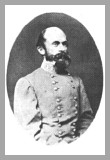
|
Maj. Gen. J.E.B. Stuart, screening the movements of general Lee's Army, took a parallel route to the east of Lt. Gen. Richard Ewell's II Corps. Unknown to General Lee and his Lieutenants, the Army of the Potomac was also moving north. It was approximately two days march behind the Confederate army and keeping itself between General Lee's army and the Federal capital of Washington, D.C.
|
|
Union Brig. Gen. Alfred Pleasonton, who had taken over command of the Union cavalry in May 1863 and fresh from his battle he and his cavalry fought against that of General Stuart at Brandy Station, Va., on June 9, had been working hard to build not only his own professional reputation but also to increase his command. There was a force of 3,200 cavalry troops in Washington D.C. that was transferred to his command, bringing the number of his force to 12,000. General Pleasonton had also reorganized the command structure of the cavalry. Brigadier Generals John Buford and David Gregg retained command of the 1st and 2nd divisions respectively. The 3rd Division of the cavalry corps was under the command of Brigadier General Judson Kilpatrick. Confederate General J.E.B. Stuart was about to test the mettle of the newly organized Union cavalry. General Lee gave General Stuart a lot of discretion in his choice of routes and targets of opportunity. He did however, direct him to "feel the right of Ewell's troops" and "collect all the supplies you can for the use of the army." General Stuart decided to ride around the Federal army, as he had done to General McClellan during the Peninsula campaign in 1862.
|
|
General Stuart led his troops on the march starting at Salem, Va., near Thoroughfare Gap, on June 24, 1863. His three brigades were commanded by Brig. Gen. Wade Hampton, Brig. Gen. Fitzhugh ("Fitz") Lee and Colonel John Chambliss. He also took along six pieces of artillery. Colonel Chambliss had been given command of Brig. Gen. W.H.F. ("Rooney") Lee's brigade after Brigadier General Lee had received a serious wound to his thigh, at Brandy Station.
|
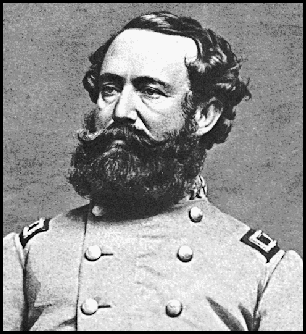
|
|
The Army of the Potomac was reportedly "inactive and at ease in their camps" aqccording to Partisan Ranger John Mosby. However, the whole Union army was on the move, making it almost impossible for Stuart's own movements to go unseen. General Stuart's van guard made contact with Union Maj. Gen. Winfield Scott Hancock's II Corps near Haymarket. The Confederate artillery lobbed a few shells toward General Hancock's men, who immediately returned the favor. This prompted General Stuart to turn his forces toward Bristoe Station and on to Wolf Run Shoals on June 26, 1863. On June 28, 1863 the Army of Northern Virginia, save two brigades of cavalry were on the north side of the Potomac.
|
|
At Rockville, Md., a mere 13 miles northwest of the Federal capital, General Wade Hampton's and Colonel Chambliss' brigades came across an eight-mile-long Union wagon train, which they captured. This wagon train was comprised of 125 wagons, 900 mules, loaded with oats, whiskey, bacon, hams and sugar. They also captured 400 Union prisoners. General Stuart and his cavalry had been on the road for more than 72 hours and had no information on the whereabouts of General Lee and the rest of the Confederate Army. He was further slowed by the long and slow-moving wagon train. Only after marching all night, General Stuart and his troops reached the tracks of the B&O Railroad, tore up a stretch of track and cut some telegraph wires. After a small skirmish with a detachment of the 1st Delaware Cavalry, at Westminister, the Confederate troopers bivouacked for the night at Union Mills, Md., less than 10 miles from the MarylandPennsylvania line.
|
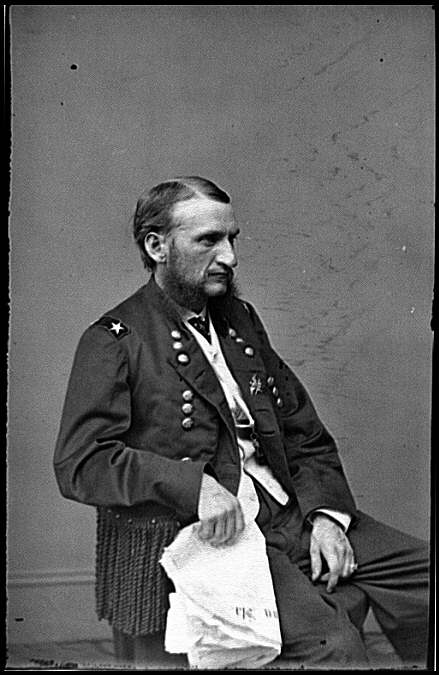
|
General Kilpatrick, who had been moving steadily northward, was unaware that General Stuart's cavalry was only a few miles away near Union Mills. General Kilpatrick was concentrating all his efforts in finding the army of Major General Jubal Early's division. General Early's division had been spotted earlier near York, Pa. Early on June 30,1863... Union General Kilpatrick (later known as "Kilcavalry"), headed his troops northeast toward Hanover, Pa. General Stuart's troops were also advancing on Hanover, with Colonel Chambliss' brigade at the point, General Wade Hampton's brigade bringing up the rear along with the captured wagon train. General Fitzhugh Lee's brigade was on General Stuart's left flank near the Baltimore Pike.
|
|
Colonel Chambliss' brigade entered the town of Hanover from the south. Led by Lt. Col. William H. Payne, who was temporarily in command of the 2nd North Carolina, the Confederates attacked the untried Union troops of the 18th Pennsylvania in flank and rear, splitting the green regiment in two. The Confederates pushed the rear of the 18th Pennsylvania into the town, causing the regiment to become mixed and confused with runaway wagons, crowded ambulances and fleeing citizens. Soldiers and citizens, a mass of confused and frightened humanity, were running through alleys and side streets. General Stuart's troops now had complete control of Hanover, Pa. Hearing the fighting behind them, the Union cavalry of the 1st West Virginia and 1st Vermont, were ordered back toward Hanover. Hearing that General Stuart held Hanover, General Kilpatrick rode as hard back to town as his mount would carry him. As he arrived, his mount collapsed and died. The 5th New York countercharged against the 2nd North Carolina, temporarily stopping their drive. Union General Farnsworth arrived and found Hammond's men fighting the Confederates, and proceeded to drive the advancing Southerners toward Littlestown Pike near Buttstown, regaining control of Hanover. General Stuart personally directing troop movements during the battle, suddenly realized that he was in front of the charging Union cavalry. Trapped, he drove his horse toward his own artillery line near Westminster Road. While riding away from Federal pursuers, Stuart and his adjutant, Captain William W. Blackford, had to jump across a 15-foot-wide gully to escape. Confederate Colonel Payne, leading the 2nd North Carolina, found himself trapped, as well, near the Winebrenner tannery. He was captured by a member of the 5th New York Cavalry. After the capture of their commander, the 2nd North Carolina retreated. However, the 9th and 10th Virginia was strong enough to drive Farnsworth's men back toward Hanover. |
|
General Wade Hampton's troops, encumbered with the captured 125 wagons, could not arrive until the middle of the afternoon, and General Fitzhugh Lee's troops were fighting the 5th and 6th Michigan of the newly promoted Brigadier General George Armstrong Custer's brigade. General Stuart's artillery did manage to get four cannons on an elevated field south of town. A two-hour artillery duel followed. There was some damage to the town of Hanover, but no civilians were injured, although a number of Union troopers were.
|
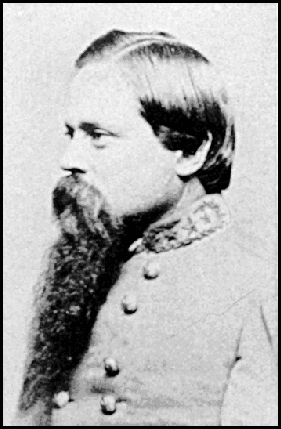
|
|
Confederate General Hampton finally arrived around 2 p.m. and positioned himself on the right of Colonel Chambliss' troops. General Hampton's artillery managed to keep Union General Farnsworth and his troops in the town. General Custer moved his 6th Michigan troopers to within 300 yards of the Confederate artillery. Opening fire at point blank range with the new seven-shot Spencer repeaters, stunning the Confederate gunners. The Confederate artillerists broke for the rear, leaving behind wounded and all their artillery pieces. General Fitzhugh Lee was able to send up reinforcements,forcing the Michigan Wolverines under General Custer to fall back to their original positions. This ended the Battle of Hanover. General Kilpatrick, not wanting to pursue the Confederates, let General Stuart's cavalry go. Leaving behind Union losses of more than 200. Riding all night, General Stuart and his troopers arrived in Dover, paroled a few hundred prisoners and sent the captured wagon train south. His next stop was in Carlisle. Here the Confederates burned some barracks belonging to the U.S. Army's cavalry school and lobbed a few artillery rounds into the town. While at Carlisle, general Stuart learned that General Lee and the rest of the Army of Northern Virginia, were at Gettysburg. Immediately, General Stuart led his troops to join General Lee, finally arriving late in the day on July 2, 1863.. too late to take part in the second day of battle in and around Gettysburg. Major General Stuart, after meeting with a disgruntled, tired and worried General Lee, was charged with guarding the Confederate army's left and with rolling up the Union right flank should the infantry capture Cemetery Ridge.
|
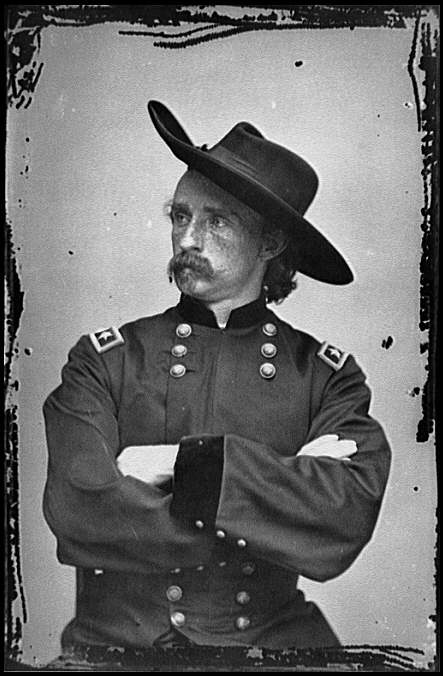
|
The Confederate cavalry made contact with the Union cavalry just three miles east of Gettysburg, near the Rummel Family farm. It was about noon on July 3, 1863. Major General Stuart deployed his forces, numbering only about 6,300, in the woods on Cress Ridge. The Union cavalry division, including the brigade commanded by General George Custer, numbering about 4,500 men, were situated along Hanover road, just to the south of the ridge.
|
|
Skirmishers were sent forward by both sides, to feel out the position and strength of the other. As contact was made, the fighting began. Major General Stuart sent troopers from the 1st Virginia charging into the enemy cavalry. The 7th Michigan countercharged and slowed and finally halted the Confederate's charge. Major General Stuart ordered Generals Wade Hampton's and Fitzhugh Lee's Brigades into a column, attacking the Union cavalry position. Marching forward to the attack, this Confederate force ran headlong into General George A.Custer's 1st Michigan (Wolverines). The fight that ensued was very violent and desperate. At times the fight was fierce hand-to-hand combat, yet neither side could gain an advantage over the other. The final act, that decided the outcome of this cavalry battle, was that of the 3rd Pennsylvania... attacking from the east. This forced a breach in the Confederate column, separating the rear portion of the Confederate force and causing them to retreat. Eventually, Major General Stuart realized his position was untennable, and feared his troops would be cutoff, ordered his troops to fall back to Cress Ridge. The outcome of this cavalry battle was uncertain. Both sides claimed victory, if there is one fact that would confirm this as a Union victory, it is the fact that Major General Stuart was denied access to the Union rear. During the night of July 4-5, General Lee ordered his battered army to begin its retreat from Gettysburg. The Army of Northern Virginia began moving southwest on the Fairfield Road toward Hagerstown and Williamsport. As he had done so many times, General Stuart and his cavalry screened the army's movements. General Meade's Union infantry followed cautiously the next day, converging on Middletown, Maryland. On July 7, Union cavalry General Buford troopers were stopped from occupying Williamsport and destroying Confederate trains. Union General Kilpatrick's division were successful in driving two Confederate cavalry brigades from Hagerstown, Md., before being forced to retire by the arrival of the rest of Stuart's command. General Lee's infantry finally reached the swollen Potomac River and could not cross. The pontoon bridge keft behind during the earlier crossing, had been destroyed by a cavalry raid. On July 11, General Lee entrenched a line, protecting the river crossings at Williamsport and prepared for Meade's army to attack. The next day,July 12, General Meade's vanguard reached the vicinity of the Confederate army and began testing its strength and positioning. July 13, The Union forces were ready for an attack, believing they had the Confederates trapped, with the river at their backs. However, the river had fallen enough to allow the construction of a new bridge, and General Lee ordered his army to begin crossing the river after dark, that evening. The following morning, July 14th, Union Generals Kilpatrick's and Buford's troops attacked the rearguard division of Confederate General Henry Heth, still on the on the north bank of the Potomac, taking more than 500 prisoners. Confederate Brigadier General James Pettigrew was mortally wounded in the fight. On July 16, Union infantry commander Gregg's forces approached Shepherdstown where Confederate General Fitzhugh Lee's and Colonel Chambliss's cavalry brigades held the Potomac River fords. The Confederate cavalry attacked the Union troops, who held out against several assults until nightfall, when they finally retired from the field. After the retreat from Gettysburg, the Confederate army passing back into Virginia by way of the Shennandoah Valley, was concentrated behind the Rapidan River in Orange County. The Union forces advanced as far as the Rappahannock River in August. As September came, they pushed forward to confront the Army of Northern Virginia along the Rapidan. It was early September when General Lee dispatched two divisions under General James Longstreet to reinforce the Confederate army of general Braxton Bragg in Georgia. Early in October, General Lee began a sweep around Union General Meade's right flank with the remaining two corps of his now dwindling army. This gutsy move forced the Federals to retreat along the Orange & Alexandria Railroad. On October 13, General Stuart, along with General Fitzhugh Lee and his cavalry brigades, made heated contact with the rearguard of the Union III Corps near Auburn. General Stuart found himself and his troopers cut off by retreating Union columns, secreted his troopers in a wooded ravine until the unsuspecting Union troops moved on. After a defeat of General Ambrose P. Hills corps at Bristoe Station as well as an aborted attempt on Centreville, General Stuart's cavalry shielded the withdrawal of the Army of Northern Virginia from the area of Manassas Junction.
|

|
General Judston Kilpatrick, wanting a decisive victory over General Stuart, pursued the Confederates along the Warrenton Turnpike. The Union cavalry was lured into an ambush near Chestnut Hill and soundly defeated and forced to retreat from the field in a total rout. Gewneral Stuart's troops chased the Federal troopers for five miles, a chase that would come to be known as the "Buckland Races." By November 7, the Union army was finally able to force passage across the Rappahannock River at two different places; overrunning the Confederate bridgehead at Rappahannock Station, and at Kelly's Ford. The Confederates retreated, allowing the Union troops to cross enmasse. Once again, General Lee's Army of Northern Virginia was forced south of the Rapidan River. The Army of the Potomac occupied the area around Brandy Station and Culpeper County.
|
|
Late in the month of November, the Confederate army was encamped in and around the Mine Run area. There, at Payne's Farm and New Hope Church would be heavy fighting as Union General Meade attempted to sneak through the area known as the "Wilderness". Confederate Major General Jubal Early, in command of General Ewell's Corps, marched east on the Orange Turnpike to counter the Union move. After two thwarted attempts, General Meade came to realize the Confederate line was too strong to break and retired from the field. General Lee's army once again had repulsed the Union army's attempts to move on Richmond and the two armies went in to Winter quarters. Union General Grant in preparing his plans for the "Overland Campaign", decided that moving south toward Richmond would draw out General Lee's Army of Northern Virginia where they could be met on ground more favorable to the Federals. However, General Lee's brilliance confounded General Grant's plans as the two armies met and fought in an area known as the "Wilderness". Here the undergrowth was so thick, the two opposing forces could hardly see one another and it served to neutralize the greater strength of the Federals. Finally, General Grant determined to breakout of the Wilderness sent cavalry south to clear the way to Spotsylvania Courthouse, while the infantry was to withdraw all the while working to "keep a stern face to the enemy." General Grant was anxious to continue the fight and though hids plan called for continuous contact with his enemy his troops moved slowly south gnarled in traffic jams of men and supplies. General Lee, suspecting General Grant's true target was again the strategic crossing at Fredericksburg. In order to counter the movements of the Union juggernaut, General Lee ordered Maj. General Robert Anderson's First Corps to Spotsylvania Courthouse. On the morning of May 8,1864, Union Major General Gouverneur K. Warren's V Corps came into contact with Confederate Major General Fitzhugh Lee's cavalry division west of Spotsylvania Courthouse at Laurel Hill. In the mean time, Union Maj. General James Wilson's cavalry division swept into Spotsylvania Courthouse from the east. However, the Union troops were unaware of the arrival of General Anderson's corps and were routed in their first attempt to assault the hill. The remainder of the day was punctuated by intense artillery duels, the continuous arrival of exhausted Union troops from the "Wilderness", and the sounds of construction as the Confederate troops built formidable breastworks. By the morning of May 9, 1864; the Confederate right swung north protecting high ground and created a salient that would later be known as the "Mule Shoe". General Grant, believing that General Lee was reconcentrating his troops to the east, designed an aggressive assault plan against the Confederate left flank. However, this plan also failed because Lee was not moving to the east, and General Meade did not fully understand his commander's plans. Once again, General Lee had the foresight to protect his flanks and thwart any gains by the Union forces. General Grant, having heard of a boast of General Phil Sheridan that his Union cavalry could defeat that of Confederate General Stuart's, championed his cause and ordered General Meade to release his cavalry commander to do just that. Major General Phil Sheridan began his sweeping move toward Richmond, and General Stuart's Confederate cavalry pursued. General Sheridan determined to lure his nemisis into the open and crush the Confederate cavalry. On 10 May, 1864; the two opposing cavalry forces faced off south of Spotsylvania Courthouse. Union General Sheridan commanded three divisions, greatly outnumbering General Stuart's three brigades. General Stuart decided to divide his force and send Major General Fitzhugh Lee's brigade toward Richmond, where he hoped he would be supported by infantry troops guarding the capital. On 11 May, 1864.... with General Fitzhugh Lee positioned at a crossroads six miles north of Richmond near Yellow Tavern, he repulsed Sheridan's first assault. In the afternoon, however, General Sheridan's overpowering numbers overpowered the Confederates. Their lines fell, and during the battle, the Confederate Cavalry Commander and Chief, General James Ewell Brown Stuart received a mortal wound to the abdomen. On 12 May, 1864; General Lee suffered another terrible loss as his "Eyes of the Army" succumed to his wound and General J.E.B. Stuart was lost to the Confederacy forever.
|

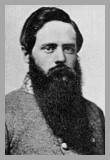
|
Brother Confederates -- I hope I may receive your pardon if I occupy a
brief portion of your time in talking to you of the Chief of Cavalry of the Army of
Northern Virginia, for my thoughts just now go out, in the language of General Johnston,
to the 'Indefatigable Stuart.' Today, comrades, I visited his grave. He sleeps his last
sleep upon a little hillside in Hollywood, in so quiet, secluded a spot that I felt indeed
that no sound 'could awake him to glory again.' A simple wooden slab marks the spot, upon
which is in scribed -- 'General Stuart, wounded May 11th, 1864; died May 12th 1864.'
And there rests poor J.E.B. Stuart.'
|
In that year I recollect, he was orderly sergeant of his company, and in his first class year its cadet captain.
I recall his distinguishing characteristics, which were a strict attention to his military duties, an erect, soldierly bearing, an immediate and almost thankful acceptance of a challenge from any cadet to fight, who might in any way feel himself aggrieved, and a clear, metallic, ringing voice.
I can well remember, when a cadet there and in the next company to his in the line at parade, always listening with eagerness, to hear him bring his company to 'order arms, parade rest -- there was so much music in his voice; and even as I speak here fancy I can almost hear it once more, sounding like the silver trumpet of the Archangel.
Little, gentlemen, did I imagine then that I would hear that same voice so often above the roar of battle and trampling of steeds upon so many hard fought fields -- still delightfully musical, calm and clear as of old -- only perhaps a little more powerful.
After his graduation, I never saw him again until the commencement of the late war. He was assigned to the First United States Cavalry, whose Colonel was Sumner and whose Lieutenant Colonel was Joseph E. Johnston. Two years later, when I graduated, I was put in the Second Cavalry, serving in Texas. My Colonel was Albert Sidney Johnson; the Lieutenant Colonel was R.E. Lee; the Majors were Hardee and George H. Thomas, and the two senior Captains Van Dorn and Kirby Smith.
Stuart served with much distinction as a United States officer; had plenty of roving, riding, and fighting Indians.
When John Brown's troops were marching on and took possession of the engine house at Harper's Ferry, Stuart was in or near Washington on leave of absence, but he immediately volunteered for the occasion, and accompanied the then Colonel R.E. Lee as his aid to that place. It was Stuart who, at great personal risk, carried the summons to surrender to Brown, and after- wards united in the charge the marines under Green made there when battering down the door, and largely contributed to end forever the career of the 'messenger and prophet,' as some at the North delighted to call him.
J.E.B. Stuart's duties began in the late war in the Valley of Virginia, as a Lieutenant Colonel of cavalry under General Johnston when he was confronting Patterson, and after that his person, his prowess, his daring, his dash, his gay humor, his great services areas familiar as 'house hold words' to all of us. Many within the sound of my voice recall him then. His strong figure, his big brown beard, his piercing, laughing blue eye, the drooping hat and black feather, the 'fighting jacket,' as he termed it, the tall cavalry boots, the high health and exuberant vitality, forming one of the most jubilant and striking figures in the war, which cannot easily be forgotten.
It was after the first battle of Manassas that my personal intercourse with him began. I in turn, as he was promoted, commanded his old regiment, his old brigade, and his old division -- being one step behind him and feel that, perhaps, I have a right to speak of him. Can I or any one else do justice to his many exploits as commander of the cavalry of the historic 'Army of Northern Virginia?'
Is it necessary to tell you that his ride around McClellan's army on the Richmond lines, was not undertaken to gain eclat by the popular applause it might bring him, but it was made to locate the flanks of the Federal army -- to blaze the way for the great Stonewall Jackson, whose memory has been so vividly recalled to us, and whom General Lee was planning to bring down upon the right and rear of McClellan, and wanted to know where it was located. I commanded a regiment upon that expedition, and know that after Stuart found himself in rear of the Federal right, his own grand genius taught him to make the circuit -- the entire circuit of the Federal army -- as the easiest way to avoid the dispositions that were being made to cut him off, should he return the way he marched.
Must I tell you of his trip to Catlett's, in Pope's rear, or of his second ride around the same McClellan, and of his ride from Chambersburg, Pennsylvania, to Leesburg, Virginia, a distance of ninety miles, in thirty six hours -- a march that has no equal in point of rapidity in the records of the war? Of his behavior upon the right of Jackson at Fredericksburg? Of Chancellorsville, where an eye witness asserts that he could not get rid of the idea that 'Harry of Navarre' was present, except that Stuart's plume was black; for everywhere, like 'Navarre,' he was in front, and the men 'followed the feather'? And where, riding at the head of and in command of Jackson's veterans, his ringing voice could be heard high, high above the thunder of artillery and the ceaseless roar of musketry, singing, 'Old Joe Hooker, won't you come out the wilderness'? Of the 9th of June, at Beverly's Ford; of Brandy Station; of Gettysburg; of his action during the memorable early days of May, 1864; of his last official dispatch, dated May 11, 1864, 6.30 A.M., where he was fighting against the immense odds of Sheridan, preventing them from occupying this city, and where he said, 'My men and horses are tired, hungry and jaded, but all right!' Of 'Yellow Tavern,' fought six miles from here, where his mortal wound was received, given when he was so close to the line of the enemy that he was firing his pistol at them? His voice -- I can even now hear -- after the fatal shot was fired, as he called out to me as I rode up to him, 'Go ahead, Fitz, old fellow, I know you will do what is right,' and constitutes my most precious legacy.
Shall I tell you when he was on the Rappahannock, and they telegraphed him his child was dying -- his darling little Flora -- that he replied that 'I shall have to leave my child in the hands of God; my duty to my country requires me here.'
Comrades, here in the city of Richmond, and for whose defence he fell, his pure spirit winged its way to heaven. Faith, which overcomes all things, was in his heart. Right here he, who on the battlefield was more fiery than even 'Rupert of the bloody sword,' quietly lay awaiting the summons of the angel of death. The bright blue eye, that always beamed with laughter, now looked into the very face of death without a quiver of the lid. About noon of the day of his death, President Davis visited his bedside, and in reply to his question as to how h

